Civil Engineering Report: Material Storage, CLT, and Sustainability
VerifiedAdded on 2023/05/28
|20
|3799
|391
Report
AI Summary
This report delves into various aspects of civil engineering, beginning with the safe and efficient storage of construction materials, emphasizing the importance of coordination between contractors, suppliers, and clients. It outlines proper waste storage procedures, including the handling of non-hazardous and demolition waste, and the recycling of materials like concrete, asphalt, masonry, wood, and metals. The report then examines cross-laminated timber (CLT) from an environmental and sustainability perspective, highlighting its recyclability, ease of demolition, limited waste generation, durability, and environmental friendliness. Finally, it discusses material selection for buildings, comparing the advantages and disadvantages of steel and concrete, proposing bamboo as an alternative, and detailing relevant standards and testing procedures. The report also references Garitage Park in Bulgaria as an example of sustainable construction practices.
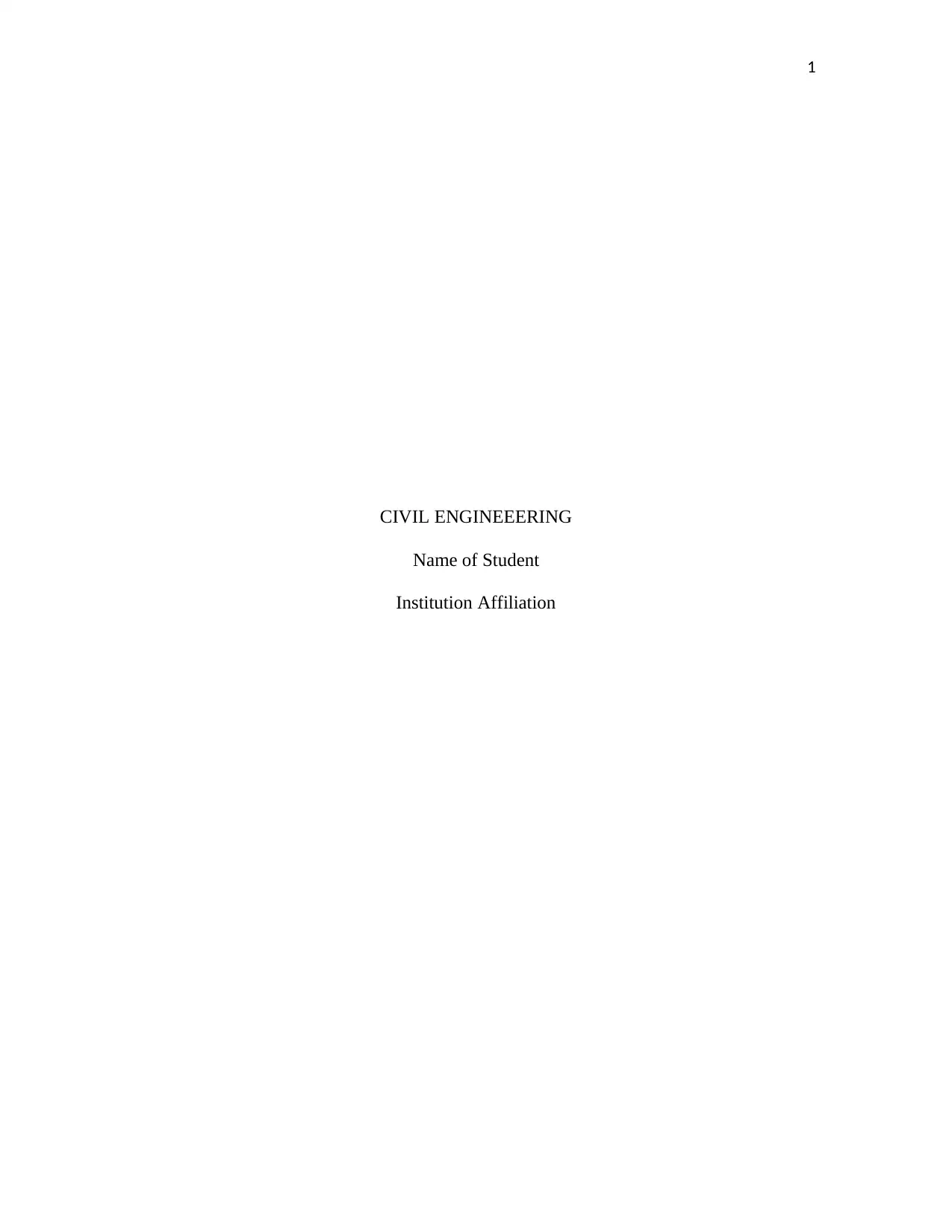
1
CIVIL ENGINEEERING
Name of Student
Institution Affiliation
CIVIL ENGINEEERING
Name of Student
Institution Affiliation
Paraphrase This Document
Need a fresh take? Get an instant paraphrase of this document with our AI Paraphraser
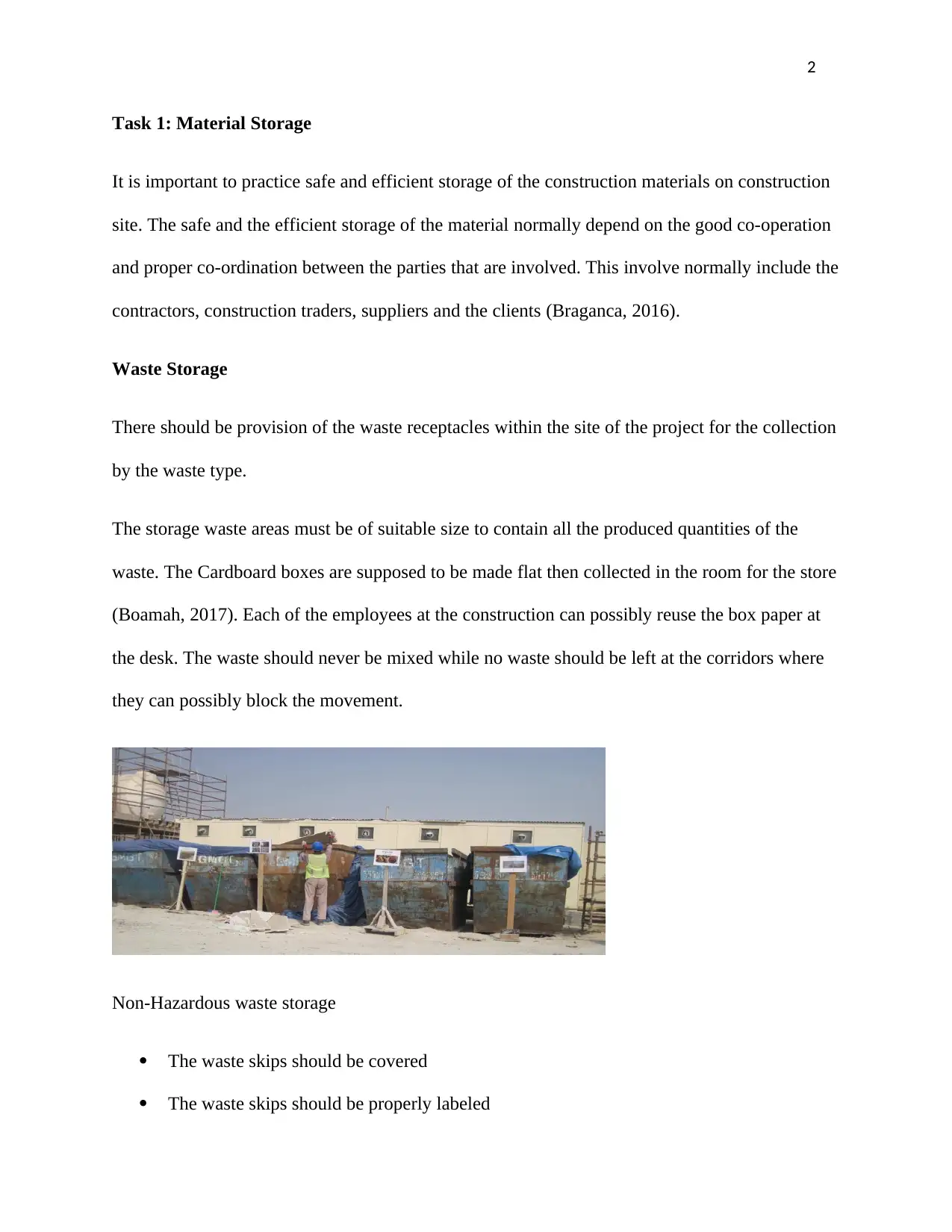
2
Task 1: Material Storage
It is important to practice safe and efficient storage of the construction materials on construction
site. The safe and the efficient storage of the material normally depend on the good co-operation
and proper co-ordination between the parties that are involved. This involve normally include the
contractors, construction traders, suppliers and the clients (Braganca, 2016).
Waste Storage
There should be provision of the waste receptacles within the site of the project for the collection
by the waste type.
The storage waste areas must be of suitable size to contain all the produced quantities of the
waste. The Cardboard boxes are supposed to be made flat then collected in the room for the store
(Boamah, 2017). Each of the employees at the construction can possibly reuse the box paper at
the desk. The waste should never be mixed while no waste should be left at the corridors where
they can possibly block the movement.
Non-Hazardous waste storage
The waste skips should be covered
The waste skips should be properly labeled
Task 1: Material Storage
It is important to practice safe and efficient storage of the construction materials on construction
site. The safe and the efficient storage of the material normally depend on the good co-operation
and proper co-ordination between the parties that are involved. This involve normally include the
contractors, construction traders, suppliers and the clients (Braganca, 2016).
Waste Storage
There should be provision of the waste receptacles within the site of the project for the collection
by the waste type.
The storage waste areas must be of suitable size to contain all the produced quantities of the
waste. The Cardboard boxes are supposed to be made flat then collected in the room for the store
(Boamah, 2017). Each of the employees at the construction can possibly reuse the box paper at
the desk. The waste should never be mixed while no waste should be left at the corridors where
they can possibly block the movement.
Non-Hazardous waste storage
The waste skips should be covered
The waste skips should be properly labeled
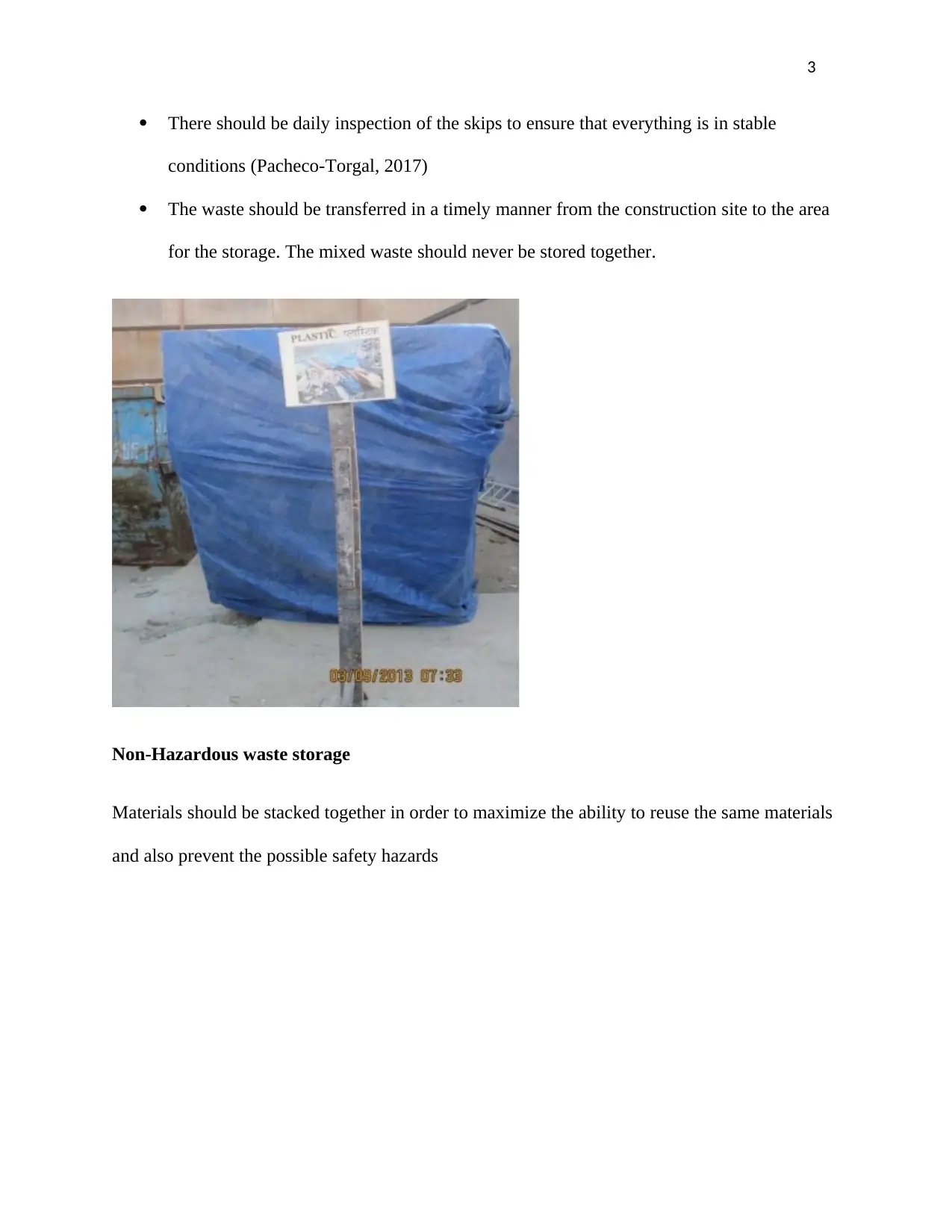
3
There should be daily inspection of the skips to ensure that everything is in stable
conditions (Pacheco-Torgal, 2017)
The waste should be transferred in a timely manner from the construction site to the area
for the storage. The mixed waste should never be stored together.
Non-Hazardous waste storage
Materials should be stacked together in order to maximize the ability to reuse the same materials
and also prevent the possible safety hazards
There should be daily inspection of the skips to ensure that everything is in stable
conditions (Pacheco-Torgal, 2017)
The waste should be transferred in a timely manner from the construction site to the area
for the storage. The mixed waste should never be stored together.
Non-Hazardous waste storage
Materials should be stacked together in order to maximize the ability to reuse the same materials
and also prevent the possible safety hazards
⊘ This is a preview!⊘
Do you want full access?
Subscribe today to unlock all pages.

Trusted by 1+ million students worldwide

4
Demolition waste in the construction site include the following
Concrete
Concrete reinforcing material
Brick
Wood joists
Wood studs
Wood trim
Wood paneling
Plywood and oriented strand wood
Concrete masonry units
Insulation
Roofing
Rough hardware
Structural steel
Demolition waste in the construction site include the following
Concrete
Concrete reinforcing material
Brick
Wood joists
Wood studs
Wood trim
Wood paneling
Plywood and oriented strand wood
Concrete masonry units
Insulation
Roofing
Rough hardware
Structural steel
Paraphrase This Document
Need a fresh take? Get an instant paraphrase of this document with our AI Paraphraser

5
Doors and the frames, windows, glazing, material studs, carpets, carpet pad, equipment, cabinet,
acoustical tiles and also panels, metal studs and the demountable portions. Valves,
Sprinklers ,Plumbing fixtures, Supports and hangers, Electrical conduit, Piping , Mechanical
equipment, Refrigerants, Copper wiring, Switchgear and panel boards, Lamps, Ballasts,
Electrical devices, Lighting fixtures , and Transformers (Palomo, 2017)
Safety storage and the subsequent recycling
Concrete: The reinforcement material and other materials should be removed and the properties
sorted properly
Asphalt material of the concrete: The paving material for the construction should be broken and
then used as the new asphalt material.
Masonry: The metal reinforcement is removed, ties and anchors from the masonry and then
sorted with other metals (Sullenger, 2018).
Wood materials
The members should be sorted and then stacked together as per the size and also length. The
lumber should be separated, engineered wood products and also the products of the panel.
Metals: Separate the metals by the type. For the cases of the steel that are also the structural
members, the stack is grouped as per the size, length and the type. The bolts are removed
including nuts, washers and the other rough hardware (Kaspar, 2017).
The asphalt shingle roofing: The organic and the glass fiber asphalt shingles should be store
separately
Doors and the frames, windows, glazing, material studs, carpets, carpet pad, equipment, cabinet,
acoustical tiles and also panels, metal studs and the demountable portions. Valves,
Sprinklers ,Plumbing fixtures, Supports and hangers, Electrical conduit, Piping , Mechanical
equipment, Refrigerants, Copper wiring, Switchgear and panel boards, Lamps, Ballasts,
Electrical devices, Lighting fixtures , and Transformers (Palomo, 2017)
Safety storage and the subsequent recycling
Concrete: The reinforcement material and other materials should be removed and the properties
sorted properly
Asphalt material of the concrete: The paving material for the construction should be broken and
then used as the new asphalt material.
Masonry: The metal reinforcement is removed, ties and anchors from the masonry and then
sorted with other metals (Sullenger, 2018).
Wood materials
The members should be sorted and then stacked together as per the size and also length. The
lumber should be separated, engineered wood products and also the products of the panel.
Metals: Separate the metals by the type. For the cases of the steel that are also the structural
members, the stack is grouped as per the size, length and the type. The bolts are removed
including nuts, washers and the other rough hardware (Kaspar, 2017).
The asphalt shingle roofing: The organic and the glass fiber asphalt shingles should be store
separately
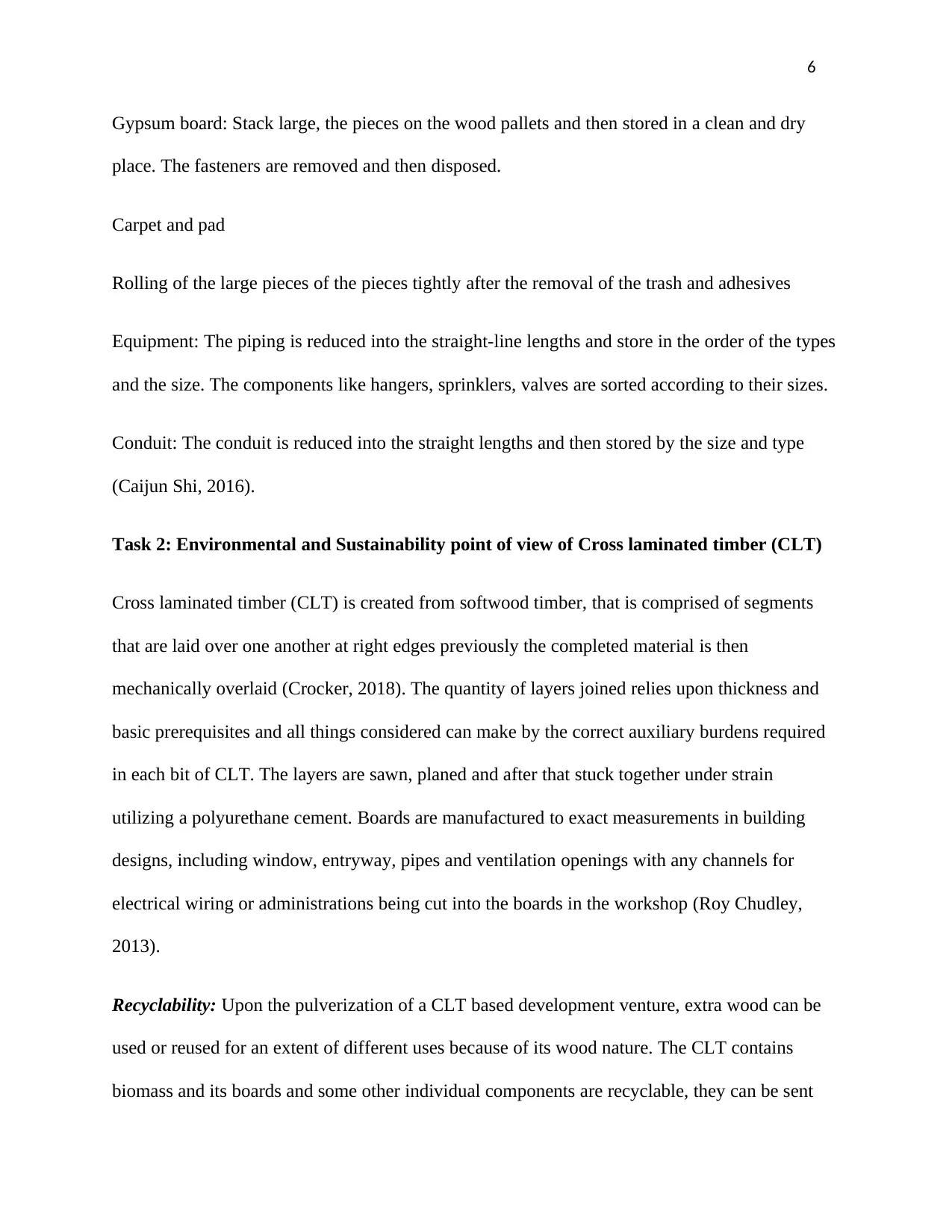
6
Gypsum board: Stack large, the pieces on the wood pallets and then stored in a clean and dry
place. The fasteners are removed and then disposed.
Carpet and pad
Rolling of the large pieces of the pieces tightly after the removal of the trash and adhesives
Equipment: The piping is reduced into the straight-line lengths and store in the order of the types
and the size. The components like hangers, sprinklers, valves are sorted according to their sizes.
Conduit: The conduit is reduced into the straight lengths and then stored by the size and type
(Caijun Shi, 2016).
Task 2: Environmental and Sustainability point of view of Cross laminated timber (CLT)
Cross laminated timber (CLT) is created from softwood timber, that is comprised of segments
that are laid over one another at right edges previously the completed material is then
mechanically overlaid (Crocker, 2018). The quantity of layers joined relies upon thickness and
basic prerequisites and all things considered can make by the correct auxiliary burdens required
in each bit of CLT. The layers are sawn, planed and after that stuck together under strain
utilizing a polyurethane cement. Boards are manufactured to exact measurements in building
designs, including window, entryway, pipes and ventilation openings with any channels for
electrical wiring or administrations being cut into the boards in the workshop (Roy Chudley,
2013).
Recyclability: Upon the pulverization of a CLT based development venture, extra wood can be
used or reused for an extent of different uses because of its wood nature. The CLT contains
biomass and its boards and some other individual components are recyclable, they can be sent
Gypsum board: Stack large, the pieces on the wood pallets and then stored in a clean and dry
place. The fasteners are removed and then disposed.
Carpet and pad
Rolling of the large pieces of the pieces tightly after the removal of the trash and adhesives
Equipment: The piping is reduced into the straight-line lengths and store in the order of the types
and the size. The components like hangers, sprinklers, valves are sorted according to their sizes.
Conduit: The conduit is reduced into the straight lengths and then stored by the size and type
(Caijun Shi, 2016).
Task 2: Environmental and Sustainability point of view of Cross laminated timber (CLT)
Cross laminated timber (CLT) is created from softwood timber, that is comprised of segments
that are laid over one another at right edges previously the completed material is then
mechanically overlaid (Crocker, 2018). The quantity of layers joined relies upon thickness and
basic prerequisites and all things considered can make by the correct auxiliary burdens required
in each bit of CLT. The layers are sawn, planed and after that stuck together under strain
utilizing a polyurethane cement. Boards are manufactured to exact measurements in building
designs, including window, entryway, pipes and ventilation openings with any channels for
electrical wiring or administrations being cut into the boards in the workshop (Roy Chudley,
2013).
Recyclability: Upon the pulverization of a CLT based development venture, extra wood can be
used or reused for an extent of different uses because of its wood nature. The CLT contains
biomass and its boards and some other individual components are recyclable, they can be sent
⊘ This is a preview!⊘
Do you want full access?
Subscribe today to unlock all pages.

Trusted by 1+ million students worldwide
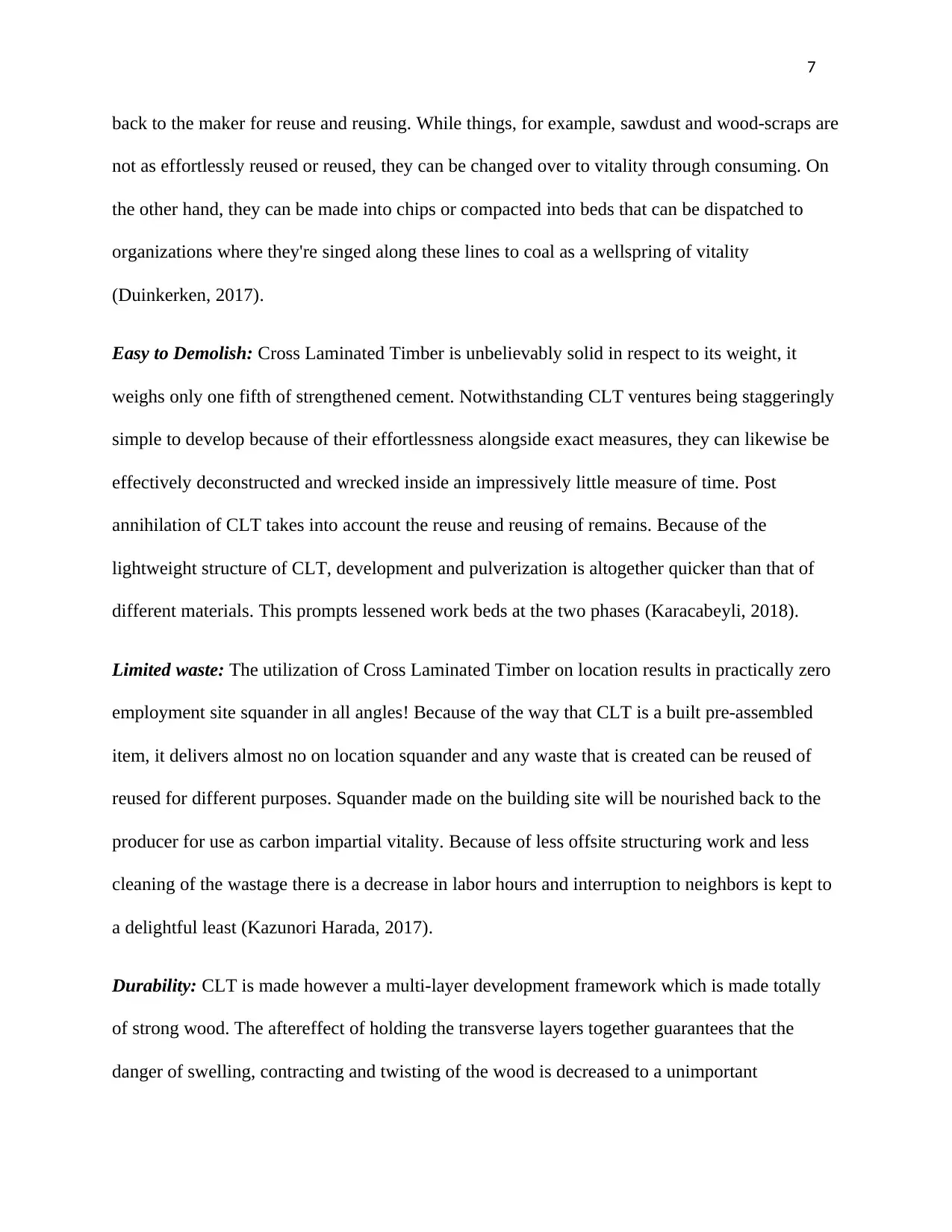
7
back to the maker for reuse and reusing. While things, for example, sawdust and wood-scraps are
not as effortlessly reused or reused, they can be changed over to vitality through consuming. On
the other hand, they can be made into chips or compacted into beds that can be dispatched to
organizations where they're singed along these lines to coal as a wellspring of vitality
(Duinkerken, 2017).
Easy to Demolish: Cross Laminated Timber is unbelievably solid in respect to its weight, it
weighs only one fifth of strengthened cement. Notwithstanding CLT ventures being staggeringly
simple to develop because of their effortlessness alongside exact measures, they can likewise be
effectively deconstructed and wrecked inside an impressively little measure of time. Post
annihilation of CLT takes into account the reuse and reusing of remains. Because of the
lightweight structure of CLT, development and pulverization is altogether quicker than that of
different materials. This prompts lessened work beds at the two phases (Karacabeyli, 2018).
Limited waste: The utilization of Cross Laminated Timber on location results in practically zero
employment site squander in all angles! Because of the way that CLT is a built pre-assembled
item, it delivers almost no on location squander and any waste that is created can be reused of
reused for different purposes. Squander made on the building site will be nourished back to the
producer for use as carbon impartial vitality. Because of less offsite structuring work and less
cleaning of the wastage there is a decrease in labor hours and interruption to neighbors is kept to
a delightful least (Kazunori Harada, 2017).
Durability: CLT is made however a multi-layer development framework which is made totally
of strong wood. The aftereffect of holding the transverse layers together guarantees that the
danger of swelling, contracting and twisting of the wood is decreased to a unimportant
back to the maker for reuse and reusing. While things, for example, sawdust and wood-scraps are
not as effortlessly reused or reused, they can be changed over to vitality through consuming. On
the other hand, they can be made into chips or compacted into beds that can be dispatched to
organizations where they're singed along these lines to coal as a wellspring of vitality
(Duinkerken, 2017).
Easy to Demolish: Cross Laminated Timber is unbelievably solid in respect to its weight, it
weighs only one fifth of strengthened cement. Notwithstanding CLT ventures being staggeringly
simple to develop because of their effortlessness alongside exact measures, they can likewise be
effectively deconstructed and wrecked inside an impressively little measure of time. Post
annihilation of CLT takes into account the reuse and reusing of remains. Because of the
lightweight structure of CLT, development and pulverization is altogether quicker than that of
different materials. This prompts lessened work beds at the two phases (Karacabeyli, 2018).
Limited waste: The utilization of Cross Laminated Timber on location results in practically zero
employment site squander in all angles! Because of the way that CLT is a built pre-assembled
item, it delivers almost no on location squander and any waste that is created can be reused of
reused for different purposes. Squander made on the building site will be nourished back to the
producer for use as carbon impartial vitality. Because of less offsite structuring work and less
cleaning of the wastage there is a decrease in labor hours and interruption to neighbors is kept to
a delightful least (Kazunori Harada, 2017).
Durability: CLT is made however a multi-layer development framework which is made totally
of strong wood. The aftereffect of holding the transverse layers together guarantees that the
danger of swelling, contracting and twisting of the wood is decreased to a unimportant
Paraphrase This Document
Need a fresh take? Get an instant paraphrase of this document with our AI Paraphraser
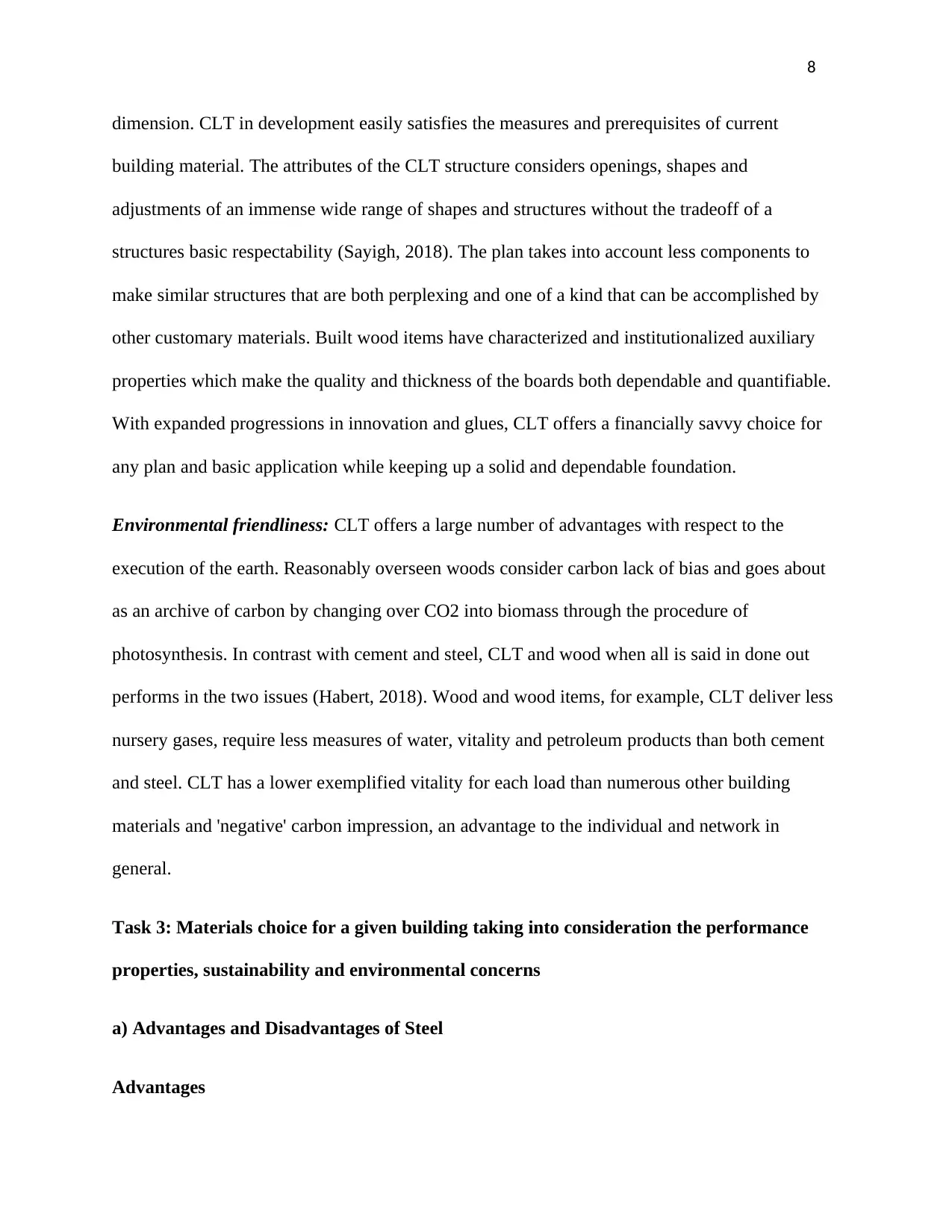
8
dimension. CLT in development easily satisfies the measures and prerequisites of current
building material. The attributes of the CLT structure considers openings, shapes and
adjustments of an immense wide range of shapes and structures without the tradeoff of a
structures basic respectability (Sayigh, 2018). The plan takes into account less components to
make similar structures that are both perplexing and one of a kind that can be accomplished by
other customary materials. Built wood items have characterized and institutionalized auxiliary
properties which make the quality and thickness of the boards both dependable and quantifiable.
With expanded progressions in innovation and glues, CLT offers a financially savvy choice for
any plan and basic application while keeping up a solid and dependable foundation.
Environmental friendliness: CLT offers a large number of advantages with respect to the
execution of the earth. Reasonably overseen woods consider carbon lack of bias and goes about
as an archive of carbon by changing over CO2 into biomass through the procedure of
photosynthesis. In contrast with cement and steel, CLT and wood when all is said in done out
performs in the two issues (Habert, 2018). Wood and wood items, for example, CLT deliver less
nursery gases, require less measures of water, vitality and petroleum products than both cement
and steel. CLT has a lower exemplified vitality for each load than numerous other building
materials and 'negative' carbon impression, an advantage to the individual and network in
general.
Task 3: Materials choice for a given building taking into consideration the performance
properties, sustainability and environmental concerns
a) Advantages and Disadvantages of Steel
Advantages
dimension. CLT in development easily satisfies the measures and prerequisites of current
building material. The attributes of the CLT structure considers openings, shapes and
adjustments of an immense wide range of shapes and structures without the tradeoff of a
structures basic respectability (Sayigh, 2018). The plan takes into account less components to
make similar structures that are both perplexing and one of a kind that can be accomplished by
other customary materials. Built wood items have characterized and institutionalized auxiliary
properties which make the quality and thickness of the boards both dependable and quantifiable.
With expanded progressions in innovation and glues, CLT offers a financially savvy choice for
any plan and basic application while keeping up a solid and dependable foundation.
Environmental friendliness: CLT offers a large number of advantages with respect to the
execution of the earth. Reasonably overseen woods consider carbon lack of bias and goes about
as an archive of carbon by changing over CO2 into biomass through the procedure of
photosynthesis. In contrast with cement and steel, CLT and wood when all is said in done out
performs in the two issues (Habert, 2018). Wood and wood items, for example, CLT deliver less
nursery gases, require less measures of water, vitality and petroleum products than both cement
and steel. CLT has a lower exemplified vitality for each load than numerous other building
materials and 'negative' carbon impression, an advantage to the individual and network in
general.
Task 3: Materials choice for a given building taking into consideration the performance
properties, sustainability and environmental concerns
a) Advantages and Disadvantages of Steel
Advantages
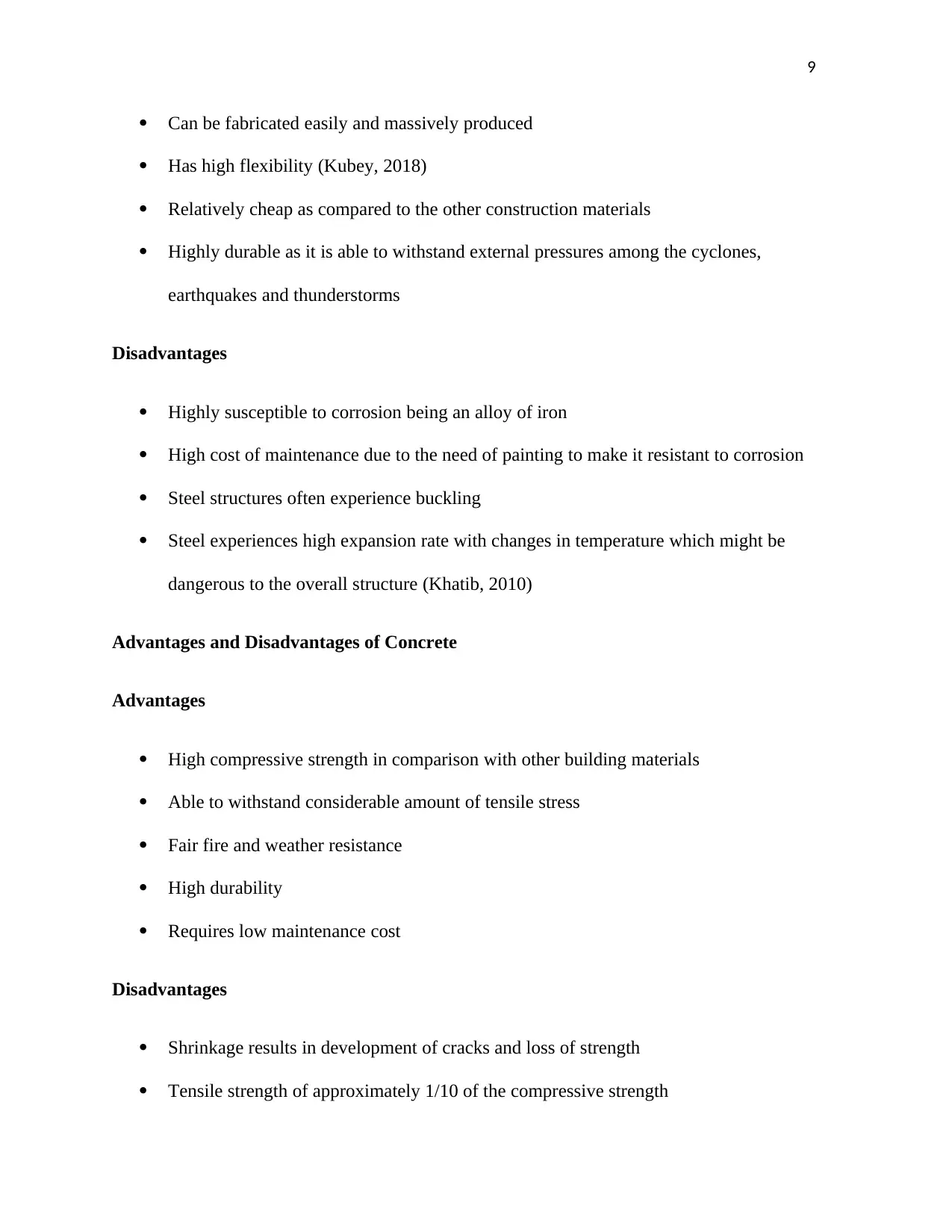
9
Can be fabricated easily and massively produced
Has high flexibility (Kubey, 2018)
Relatively cheap as compared to the other construction materials
Highly durable as it is able to withstand external pressures among the cyclones,
earthquakes and thunderstorms
Disadvantages
Highly susceptible to corrosion being an alloy of iron
High cost of maintenance due to the need of painting to make it resistant to corrosion
Steel structures often experience buckling
Steel experiences high expansion rate with changes in temperature which might be
dangerous to the overall structure (Khatib, 2010)
Advantages and Disadvantages of Concrete
Advantages
High compressive strength in comparison with other building materials
Able to withstand considerable amount of tensile stress
Fair fire and weather resistance
High durability
Requires low maintenance cost
Disadvantages
Shrinkage results in development of cracks and loss of strength
Tensile strength of approximately 1/10 of the compressive strength
Can be fabricated easily and massively produced
Has high flexibility (Kubey, 2018)
Relatively cheap as compared to the other construction materials
Highly durable as it is able to withstand external pressures among the cyclones,
earthquakes and thunderstorms
Disadvantages
Highly susceptible to corrosion being an alloy of iron
High cost of maintenance due to the need of painting to make it resistant to corrosion
Steel structures often experience buckling
Steel experiences high expansion rate with changes in temperature which might be
dangerous to the overall structure (Khatib, 2010)
Advantages and Disadvantages of Concrete
Advantages
High compressive strength in comparison with other building materials
Able to withstand considerable amount of tensile stress
Fair fire and weather resistance
High durability
Requires low maintenance cost
Disadvantages
Shrinkage results in development of cracks and loss of strength
Tensile strength of approximately 1/10 of the compressive strength
⊘ This is a preview!⊘
Do you want full access?
Subscribe today to unlock all pages.

Trusted by 1+ million students worldwide
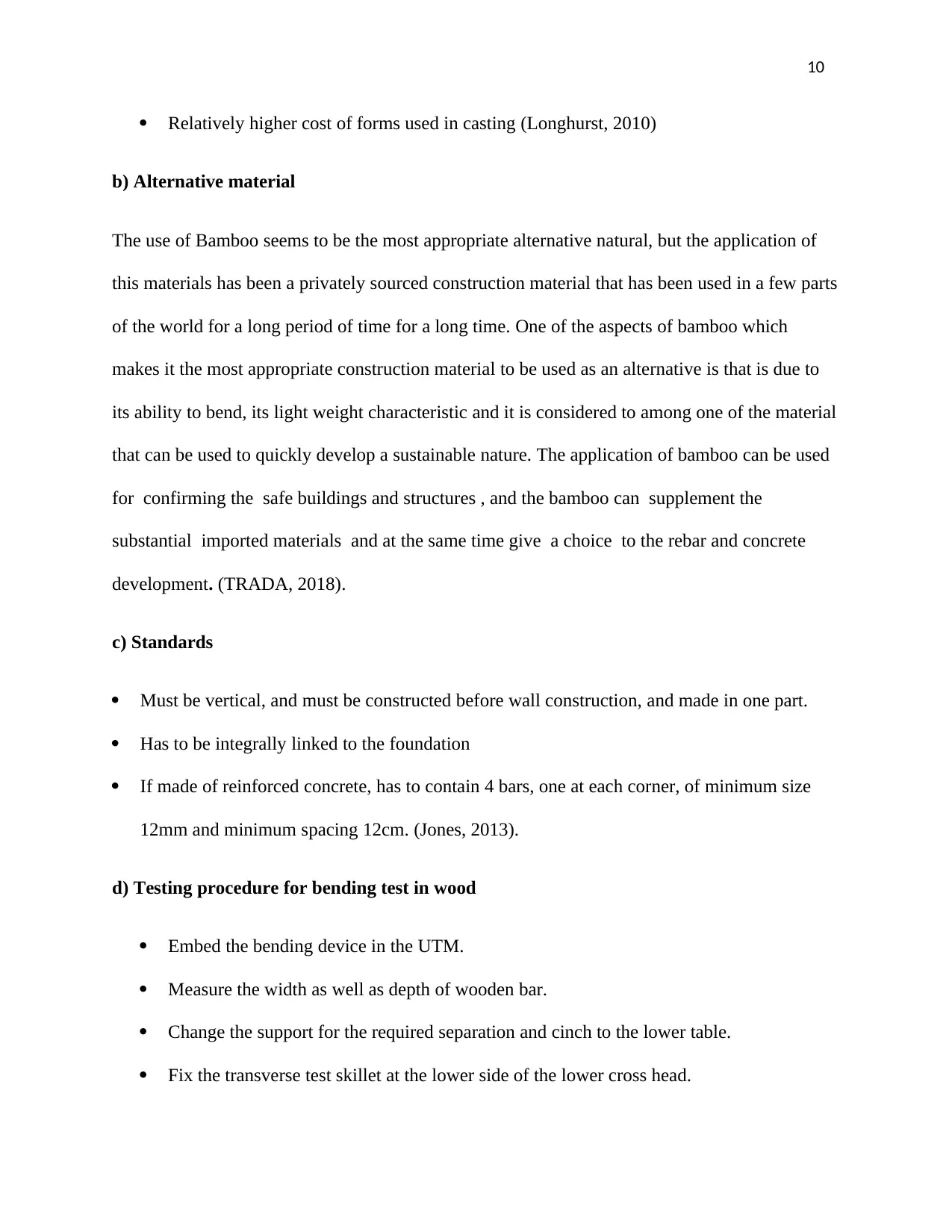
10
Relatively higher cost of forms used in casting (Longhurst, 2010)
b) Alternative material
The use of Bamboo seems to be the most appropriate alternative natural, but the application of
this materials has been a privately sourced construction material that has been used in a few parts
of the world for a long period of time for a long time. One of the aspects of bamboo which
makes it the most appropriate construction material to be used as an alternative is that is due to
its ability to bend, its light weight characteristic and it is considered to among one of the material
that can be used to quickly develop a sustainable nature. The application of bamboo can be used
for confirming the safe buildings and structures , and the bamboo can supplement the
substantial imported materials and at the same time give a choice to the rebar and concrete
development. (TRADA, 2018).
c) Standards
Must be vertical, and must be constructed before wall construction, and made in one part.
Has to be integrally linked to the foundation
If made of reinforced concrete, has to contain 4 bars, one at each corner, of minimum size
12mm and minimum spacing 12cm. (Jones, 2013).
d) Testing procedure for bending test in wood
Embed the bending device in the UTM.
Measure the width as well as depth of wooden bar.
Change the support for the required separation and cinch to the lower table.
Fix the transverse test skillet at the lower side of the lower cross head.
Relatively higher cost of forms used in casting (Longhurst, 2010)
b) Alternative material
The use of Bamboo seems to be the most appropriate alternative natural, but the application of
this materials has been a privately sourced construction material that has been used in a few parts
of the world for a long period of time for a long time. One of the aspects of bamboo which
makes it the most appropriate construction material to be used as an alternative is that is due to
its ability to bend, its light weight characteristic and it is considered to among one of the material
that can be used to quickly develop a sustainable nature. The application of bamboo can be used
for confirming the safe buildings and structures , and the bamboo can supplement the
substantial imported materials and at the same time give a choice to the rebar and concrete
development. (TRADA, 2018).
c) Standards
Must be vertical, and must be constructed before wall construction, and made in one part.
Has to be integrally linked to the foundation
If made of reinforced concrete, has to contain 4 bars, one at each corner, of minimum size
12mm and minimum spacing 12cm. (Jones, 2013).
d) Testing procedure for bending test in wood
Embed the bending device in the UTM.
Measure the width as well as depth of wooden bar.
Change the support for the required separation and cinch to the lower table.
Fix the transverse test skillet at the lower side of the lower cross head.
Paraphrase This Document
Need a fresh take? Get an instant paraphrase of this document with our AI Paraphraser
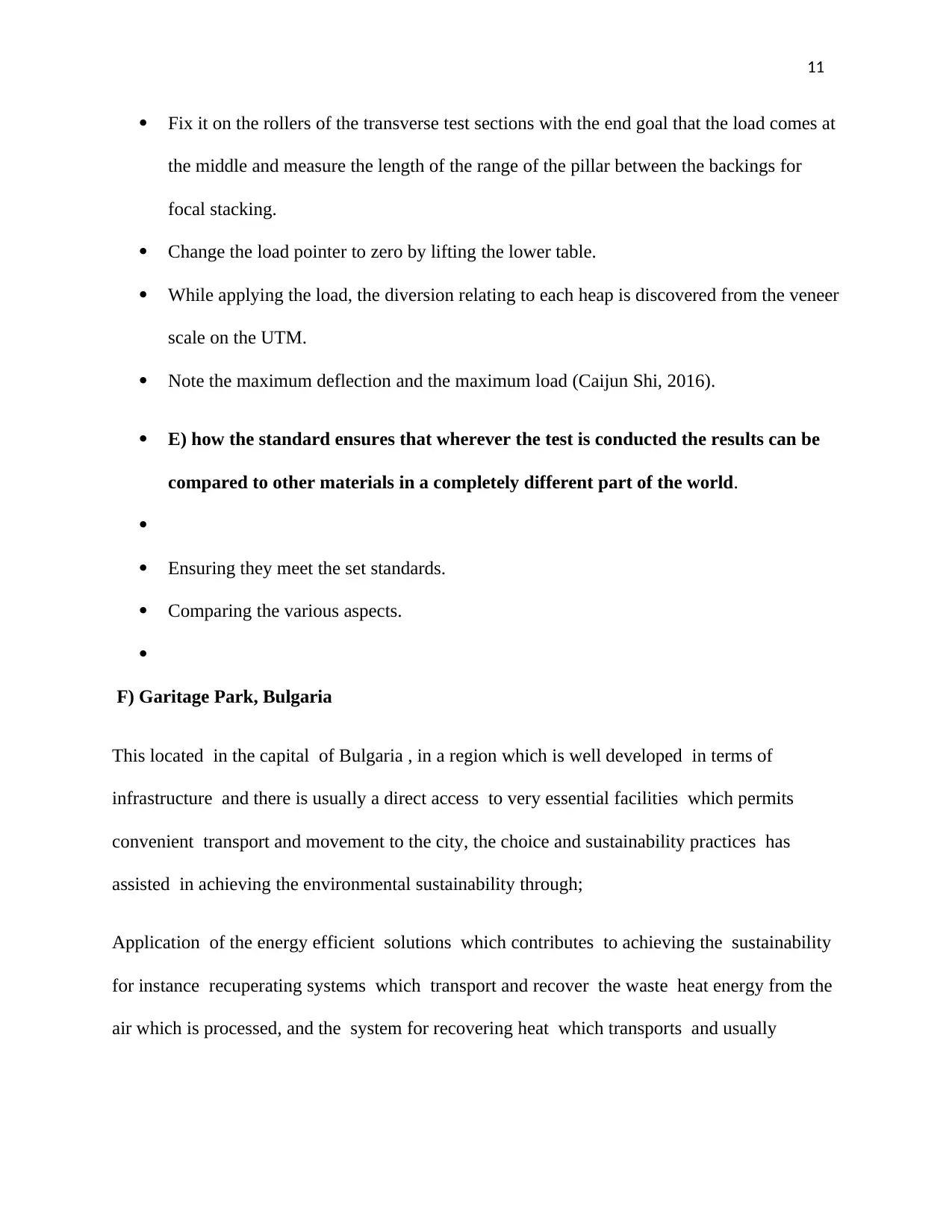
11
Fix it on the rollers of the transverse test sections with the end goal that the load comes at
the middle and measure the length of the range of the pillar between the backings for
focal stacking.
Change the load pointer to zero by lifting the lower table.
While applying the load, the diversion relating to each heap is discovered from the veneer
scale on the UTM.
Note the maximum deflection and the maximum load (Caijun Shi, 2016).
E) how the standard ensures that wherever the test is conducted the results can be
compared to other materials in a completely different part of the world.
Ensuring they meet the set standards.
Comparing the various aspects.
F) Garitage Park, Bulgaria
This located in the capital of Bulgaria , in a region which is well developed in terms of
infrastructure and there is usually a direct access to very essential facilities which permits
convenient transport and movement to the city, the choice and sustainability practices has
assisted in achieving the environmental sustainability through;
Application of the energy efficient solutions which contributes to achieving the sustainability
for instance recuperating systems which transport and recover the waste heat energy from the
air which is processed, and the system for recovering heat which transports and usually
Fix it on the rollers of the transverse test sections with the end goal that the load comes at
the middle and measure the length of the range of the pillar between the backings for
focal stacking.
Change the load pointer to zero by lifting the lower table.
While applying the load, the diversion relating to each heap is discovered from the veneer
scale on the UTM.
Note the maximum deflection and the maximum load (Caijun Shi, 2016).
E) how the standard ensures that wherever the test is conducted the results can be
compared to other materials in a completely different part of the world.
Ensuring they meet the set standards.
Comparing the various aspects.
F) Garitage Park, Bulgaria
This located in the capital of Bulgaria , in a region which is well developed in terms of
infrastructure and there is usually a direct access to very essential facilities which permits
convenient transport and movement to the city, the choice and sustainability practices has
assisted in achieving the environmental sustainability through;
Application of the energy efficient solutions which contributes to achieving the sustainability
for instance recuperating systems which transport and recover the waste heat energy from the
air which is processed, and the system for recovering heat which transports and usually
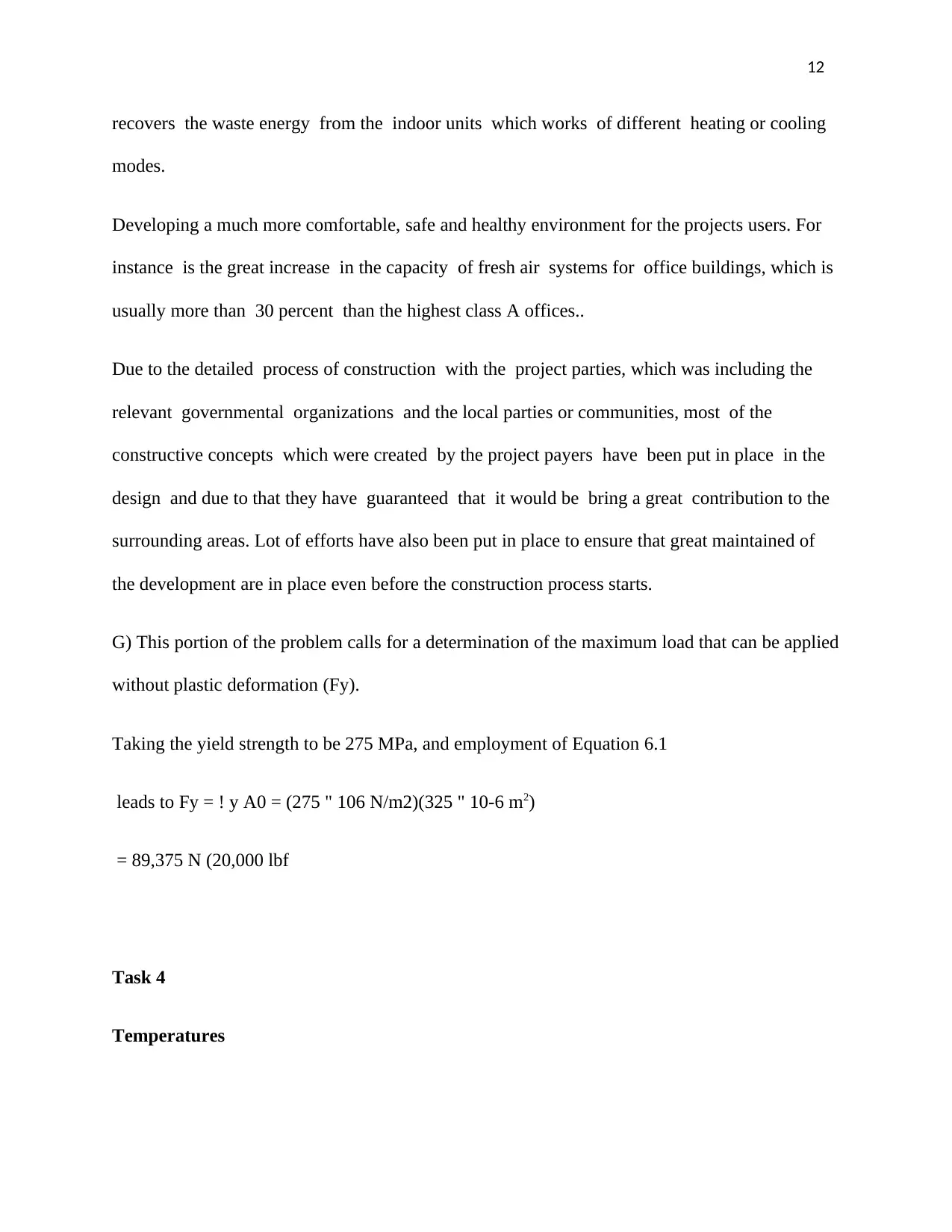
12
recovers the waste energy from the indoor units which works of different heating or cooling
modes.
Developing a much more comfortable, safe and healthy environment for the projects users. For
instance is the great increase in the capacity of fresh air systems for office buildings, which is
usually more than 30 percent than the highest class A offices..
Due to the detailed process of construction with the project parties, which was including the
relevant governmental organizations and the local parties or communities, most of the
constructive concepts which were created by the project payers have been put in place in the
design and due to that they have guaranteed that it would be bring a great contribution to the
surrounding areas. Lot of efforts have also been put in place to ensure that great maintained of
the development are in place even before the construction process starts.
G) This portion of the problem calls for a determination of the maximum load that can be applied
without plastic deformation (Fy).
Taking the yield strength to be 275 MPa, and employment of Equation 6.1
leads to Fy = ! y A0 = (275 " 106 N/m2)(325 " 10-6 m2)
= 89,375 N (20,000 lbf
Task 4
Temperatures
recovers the waste energy from the indoor units which works of different heating or cooling
modes.
Developing a much more comfortable, safe and healthy environment for the projects users. For
instance is the great increase in the capacity of fresh air systems for office buildings, which is
usually more than 30 percent than the highest class A offices..
Due to the detailed process of construction with the project parties, which was including the
relevant governmental organizations and the local parties or communities, most of the
constructive concepts which were created by the project payers have been put in place in the
design and due to that they have guaranteed that it would be bring a great contribution to the
surrounding areas. Lot of efforts have also been put in place to ensure that great maintained of
the development are in place even before the construction process starts.
G) This portion of the problem calls for a determination of the maximum load that can be applied
without plastic deformation (Fy).
Taking the yield strength to be 275 MPa, and employment of Equation 6.1
leads to Fy = ! y A0 = (275 " 106 N/m2)(325 " 10-6 m2)
= 89,375 N (20,000 lbf
Task 4
Temperatures
⊘ This is a preview!⊘
Do you want full access?
Subscribe today to unlock all pages.

Trusted by 1+ million students worldwide
1 out of 20
Related Documents
Your All-in-One AI-Powered Toolkit for Academic Success.
+13062052269
info@desklib.com
Available 24*7 on WhatsApp / Email
![[object Object]](/_next/static/media/star-bottom.7253800d.svg)
Unlock your academic potential
Copyright © 2020–2025 A2Z Services. All Rights Reserved. Developed and managed by ZUCOL.





